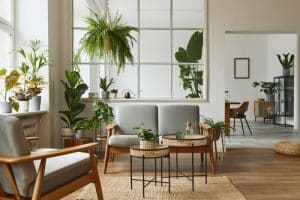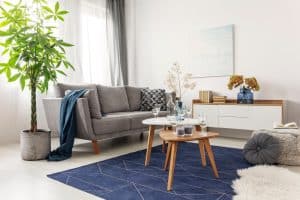Schedule a Free Consult
Schedule Your
Free Design Consultation
Free Design Consultation
With fall ending and winter rolling in, you might be missing the green foliage and bright flowers of spring and summer. If you decorate with houseplants, you’ll always have access to a green space by bringing the nature you love and crave into your home. Plants are an excellent and sometimes underappreciated decorating option for any home. Especially if your home gets lots of natural light, plants are a low-cost and low-maintenance way to improve your space with living things.
Plants are inherently beneficial to people. Plants clean the air, and the bigger and leafier the plant is, the better they are at it. Even the soil a house plant is planted in helps clean the air in your home. Removing carbon dioxide and producing oxygen means plants can actually improve your focus and alertness while encouraging healthy sleep, making plants a great choice for decorating in any room in your home.
Plants also have a demonstrated positive effect on mental health. Caring for a living thing makes you feel connected to and needed by that thing, improving outlook and mood over all, and while pets allow you to connect with your animal directly, plants create a connection between you and nature and your environment in general.

There are innumerable kinds of houseplants, and it can seem pretty intimidating trying to decide which plants you want to decorate with. There are a few easy and beautiful plants that make for excellent “starter” plants, a few of which you can find below:
If you’re still unsure about what kind of plants you want, head to a nursery and ask someone for help! Horticulturists love plants, and many will enjoy the opportunity to introduce a newbie to the joys of plant growing. Make sure to mention if you have pets, as some plants can be toxic to certain animals.
Whatever plants you choose, you will need to find appropriate places in your house for them. Not all plants can grow well in every environment, and most only thrive in one. Figure out the rooms and locations in your house where there is lots of light and where there is little light, and assign your plants appropriately. Humidity also plays a factor, but unless you have an enclosed porch or pool room, odds are your house has central climate control, so this likely won’t be a problem.
The aesthetic impact indoor plants goes well beyond the plants themselves. You’ll need to pot them, which provides you with an excellent opportunity to make a statement or blend your houseplants seamlessly into your existing décor.
Pots are most often made of earthenware or plastic. Earthenware pots, either terracotta or glazed, are what we recommend for small- to medium-sized houseplants. Terracotta goes with virtually every style you can imagine, but if you want a more specific look, glazed pots come in anything from plain white to elaborate multi-colored designs.

Before you go to buy your pots, take a walk through the rooms you want your plants in so the way they make you feel is fresh in your mind. You should also take some pictures or commit to memory the size of the plants you are potting. Plants need enough space to grow, so make sure you’re buying pots that aren’t too small. The plastic pots plants come in are a good gauge; the pot you buy should be noticeably bigger than the pot the plant came in.
Plastic pots are a good option if you’re on a budget, but they have one specific important use. Large plants, like indoor trees such as a fiddle leaf fig, will need to have a lot of soil to stay healthy. Large plants will be heavy on their own, and if you ever need to move one, you’ll thank yourself for picking a five-pound plastic pot over a 45-pound earthenware one.
When deciding how you want to display your plants, take your pots into consideration. Pots you find particularly pleasing can be placed on top of side tables or even get their own stand, allowing people to fully appreciate the aesthetic decisions you made. For lighter-weight plants and pots, macrame nets or hangers can create a great look and free up some surfaces, if you need it.
Plants are best applied as an accent to your existing décor. Focus too much on your houseplants and your home might start to resemble a conservatory. The number one best way to employ  houseplants is to fill gaps in your décor. A bare spot of wall, an empty corner, or an undecorated hall table are all great places for plants. If you have a corner you use for your Christmas tree in winter, there’s a good chance it’s fairly bare during the rest of the year. Why not fill that with year-round plants which you can easily move to another space during the holidays?
houseplants is to fill gaps in your décor. A bare spot of wall, an empty corner, or an undecorated hall table are all great places for plants. If you have a corner you use for your Christmas tree in winter, there’s a good chance it’s fairly bare during the rest of the year. Why not fill that with year-round plants which you can easily move to another space during the holidays?
If you decide to go with a vine-y plant such as a Pothos or Spider Plant, once those vines are well grown they make excellent whimsical decorative elements. Wrap them around a mirror frame or down a bookshelf to create a fairytale fusion of craft and nature.
Since some houseplants need lots of light, you can create a lovely window display out of a few light-hungry plants. Put them on a wide window sill or install a shelf directly below the window to create a green oasis in your home.